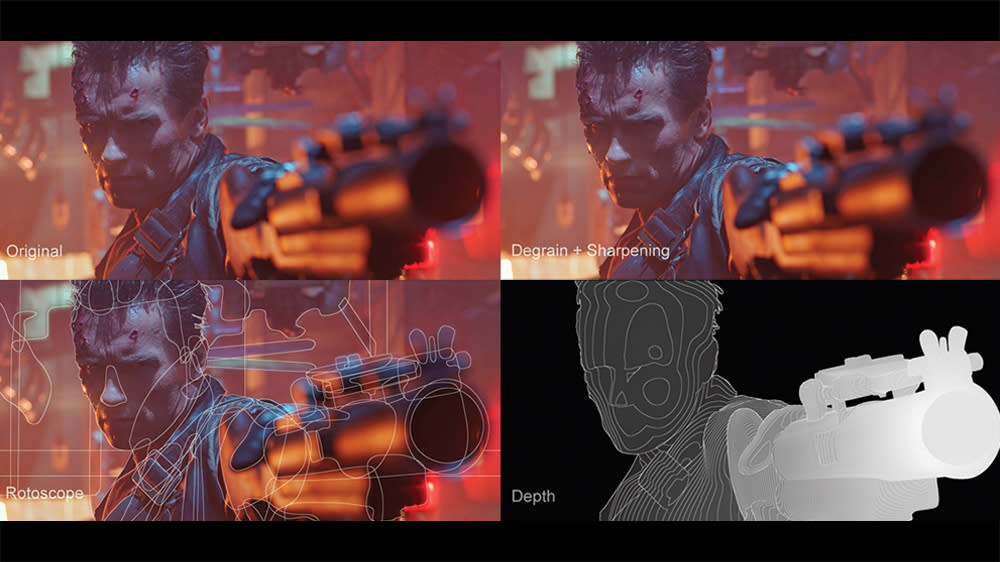‘Terminator 2’ Rerelease an Example of Changing Attitude Toward 3D Conversion

Back around 2010, all eyes in Hollywood were on the resurgent phenomenon of 3D — with more and more big-budget films shot on the format generating a hefty box office premium from moviegoers, who readily donned glasses to watch the action. While the fad hasn’t entirely fizzled, it hardly lived up to its promise of pulling the theatrical business out of the doldrums. But the search for an improved, cost-effective 3D formula continues.
One step in this direction is the rerelease of James Cameron’s seminal 1991 science-fiction blockbuster “Terminator 2: Judgment Day,” originally shown in 2D. It returns to theaters across the globe this month, newly restored in 4K and reimagined in 3D. The film’s transformation is representative of a broad industry-wide shift toward a different sort of 3D filmmaking.
Nearly a decade has passed since Cameron’s “Avatar” helped solidify the contemporary era of 3D cinema. Back then, a clean line existed between two kinds of 3D movies: those shot natively in the format using two cameras on a stereoscopic rig, as was the case with “Avatar,” and those shot in 2D and converted to 3D in post-production — often hastily, as with the criticized conversions of “Clash of the Titans,” “The Last Airbender” and “Thor.”
Moviegoers noticed the difference in quality between the two ways of generating 3D images. The prevailing belief was that while native 3D was dazzling — and worth the premium surcharge — conversions were nothing more than rush jobs designed to cash in on the craze.
William Sherak, head of conversion house Stereo D, admits that the first attempts at nonnative 3D were less than spectacular. “When we created this industry, it didn’t come with an instruction manual,” he says. “We were all doing our best to make the best product in the time allotted.” But over the past eight years, the work produced by Stereo D has greatly improved — and as it’s gotten better, the stigma around conversion jobs has diminished.
What caused the shift away from native? To begin with, filmmakers didn’t like shooting on stereo rigs, which are unwieldy and difficult to focus and maneuver. At the same time, conversion technology grew more sophisticated, less expensive and easier to use. “When the quality was about equal, and the cost lower, you started to see a lot more conversions,” Sherak says. “The more conversions you do, the more money you can put back into [a production] to make even better. Also, conversion is an artist-driven business, and the more artists work on something, the better they get.”
Today, Sherak says, Stereo D is “doing a higher-quality job cheaper and faster,” an improvement that’s apparent in the post-conversions of such titles as “Spider-Man: Homecoming” and “Star Wars: The Force Awakens.” “The world has unsoured from conversions because we’re good at it now,” Sherak stresses. “We’re never going to deliver a poor-looking product again.”
The conversion process is so well established that not one of the 23 live-action 3D films released in America this year was shot 3D native: All were conversions. In 2008, by contrast, 10 of 19 films were native 3D.
The upcoming 3D release of “Terminator 2” is a prime example of today’s 3D conversions. Like Cameron’s “Titanic” and Steven Spielberg’s “Jurassic Park” before it, “Terminator 2” is being reintroduced to the market as an event picture. François Scippa-Kohn, head of the film’s U.S. distributor, Distrib Films US, points out that the rerelease isn’t coasting on the novelty of 3D, since the format isn’t as hot as it used to be. The timing of the event is critical, he adds.
“Eight years ago the rerelease would have been too early because it would have drowned among all the 3D novelties on the market,” he says. Now, he feels, it can be viewed as a theatrical event that showcases the high quality of the conversion work — entirely supervised, frame-by-frame, by Cameron. “You’ll see the movie in a way that you have never seen it before,” he notes.
Such conversions remain hugely time-consuming, requiring, in the case of “Terminator 2,” a team of more than 1,400 artists and technicians to work for a year. Sherak credits Cameron with maintaining the job’s quality by demanding nothing but the best. “He changed our definition of perfection. When your artists have to work at that level, it makes them better. ”
Scippa-Kohn considers the director’s famed perfectionism essential to the success of the “Terminator 2” 3D rerelease: “The fact that Cameron himself did it means that people never wonder whether quality of the 3D will be great or not. He’s the master of this. Of course it’s going to be great. That was a big part of the marketing.”
Get more from Variety and Variety411: Follow us on Twitter, Facebook, Newsletter

 Yahoo Movies
Yahoo Movies 